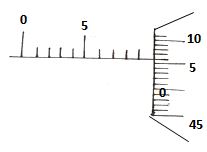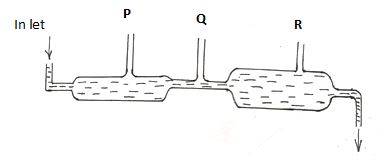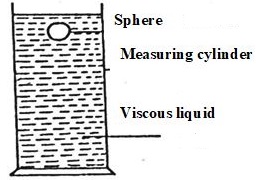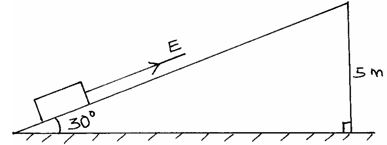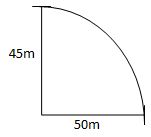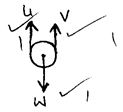Questions
Instructions
- Answer all questions in section A and B.
(take acceleration due to gravity g=10m/s2)
Section A: 25 marks
- The micrometrer screw gauge shown in figure below was found to have an error of + 0.04
Give the correct reading of the micrometer (1mk) - State an advantage of using mercury than alcohol as a thermometric liquid 1mk
- State the principle involved when determining of the centre of gravity of regular lamina using a plumb line (1mk)
- A uniform metre rule of mass 200g is pivoted at the )cm mark, calculate the force which would be applied vertically upward at the 65cm mark to keep the rule horizontal. (3mks)
- Distinguish between the terms gravitational potential energy and elastic potential energy. (2mks)
- Describe a simple experiment to demostrate that the pressure in liquid increase with depth. (3mks)
- An arrow of mass 100g is shot into a block of wood of mass 400g lying at rest on the smooth surface of an ice rink. If at the moment of impact the arrow is traveling horizontally at 15m/s. calculate the common velocity after the impact. (3mks)
- State two evidences that matter is made up of small particles (2mks)
- Distinguish between conduction and convection (1mk)
- A pump forces 12kg of water through a hose every minute. If the water is being raised vertically through 20m and ejected at the nozzle at 10m/s, calculate the power of the pump. (3mks)
- Determine the manometer which will have the lowest level between P,Q and R in the figure below. Explain your answer. [assume the water is flowing continuously from the tap to the tap to the outlet. (2mks)
- A block of metal A having a mass 40kg requires a horizontal force of 100N to drag it with uniform velocity along a horizontal surface.Calculate the co-efficient of friction (3mks)
SECTION B (55 MARKS)
-
- The figure below shows the displacement – time graph of the motion of particle.
State the nature of the motion of the particle between- A and B (1mk)
- B and C (1mk)
- C and D (1mk)
- A ball is thrown horizontally from top of a vertical tower and strikes the ground at a point 50m from the bottom of the tower. Given that the height of the tower is 45m, determine the
- Time taken by the ball to hit the ground. (2mks)
- Initial horizontal velocity of the ball (2mks)
- Vertical velocity of the ball just before striking the ground. (2mks)
- The diagram in below shows a sphere moving in a viscous liquid in a tall measuring cylinder. Show on the diagram the forces acting on the sphere. (3 marks)
- The figure below shows the displacement – time graph of the motion of particle.
- In an experiment to estimate the size of oil molecule an oil drop of diameter 0.05cm spreads over water to form a circular patch whose diameter is 15cm.
- Determine in SI units:
- Volume of the drop. (2 marks)
- Area of the patch. (2 marks)
- Size of the oil molecule. (3 marks)
- State two assumptions made in b)(iii) above. (2 marks)
- Determine in SI units:
-
- Define the term velocity ratio of a machine. (1 mark)
- A man pushes an 80kg mass load on an inclined plane and raises the load through a vertical height of 5m as shown in the diagram below. The inclined plane is 30° to the horizontal. (Take g to be 10N/kg).
- Determine the velocity ratio of the inclined plane. (2 marks)
- If the efficiency of the inclined plane is 75% determined.
- the mechanical advantage. (2 marks)
- the effort E, needed to pull the load up the plane. (2 marks)
- A trolley of height 0.2m moving on a horizontal bench of height 3.2m strikes a barrier at the edge of the bench. The object on top of the trolley flies off on impact and lands on the ground 2.5m from the edge of the bench as shown in the figure below.Use this information to answer the questions that follow.
- Give a reason why the object on the trolley flies off on impact. (1 mark)
- Determine the time taken by the object to reach the ground. (2 marks)
-
- A boy throws a tennis ball vertically upwards from a truck moving at a constant velocity.
Give the reason why the ball lands back exactly the same point where it was projected. (1 mark) - Define momentum and state its SI unit (2mark)
- A trailer of mass 30 tonnes travelling at a velocity of 72km/h runs onto a stationary bus of mass 10 tonnes. The impact takes 0.5seconds before the two vehicles move off together at a constant velocity for 15 seconds. Determine,
- The common velocity. (3 marks)
- The distance moved after the impact. (2 marks)
- The impulsive force on the trailer on impact. (3 marks)
- Give a reason why when a passenger jumps from a floating boat, the boat moves backwards. (1 mark)
- Give the reason why a safety seat belt used in a vehicle:
- Should have a wide surface area. (1 mark)
- Should be slightly extensible. (1 mark)
- A boy throws a tennis ball vertically upwards from a truck moving at a constant velocity.
-
- State Hooke’s Law. (1mk)
- The following results were obtained in a experiment to verify Hooke’s law when a spring was extended by hanging various loads on it.
- Complete the table for the extension e above. (1mk)
Load (N) 0.00 1.00 2.00 3.00 4.00 5.00 6.00 Length of spring in cm 10.00 11.50 13.00 14.50 16.00 18.00 24.00 Extension - Plot a graph of load (y-axis) against extension (3mks)
- From the graph determine the springs constant. (2mks)
- Calculate the energy stored when the spring is stretched to 16 cm.(3mks)
- Complete the table for the extension e above. (1mk)
Marking Scheme
- Main scale reading = 8.0 mm
Thimble scale reading = 6 x 0.01 = 0.06mm
Reading= 8.06 mm -0.04= 8.02mm - -----expands and contracts uniformly
------does not wet the glass
-------easily visible ----------good thermal contact - When a body is freely suspended it rests with its centre of gravity vertically below the point of suspension.
-
Clockwise moments = W x 0.5 m
Anticlockwise moment = F x 0.65m
W x 0.5 = F x 0.65
200 x 10 0.5 = F x 0.6
1000
1 = F x 0.6
0.6 0.6
F = 10 = 1.67N
6 - Gravitation potential energy is possessed by bodies due to their position i.e bodies that are able to fall down. Elastic potential energy is possessed by compressed or stretched springs.
- Apparatus
A tin, small nail , water.
Procedure
Using the nail (pin make three holes A,B and C of the same diameter along a vertical line on the side of the tin.Fill the thin with water as show below.
Observe the jets of water from the holes A,B and C
Observation
The lower hole A throws water farthest, followed by B and lastly C
Conclusion
Pressure of water at A. is greater than pressure at B and pressure at B is greater than at C. - M1V1 + M2V2 = M1V1
0.1x 15 + 0.4 x 0 = 0.5V
1.5 = 0.5
0.5 0.5 V = 3m/s -
- in Brownian motion
- A slid dissolves in a solvent
- A piece of chalk can be ground into small particles;
-
- Conduction is a process through which heat is transferred in a solid.
- Convection is a process through which heat is transferred in fluids.
- 12kg per min h = 2cm
Power workday x distance
Time
= force x distance = 40 x 20 = 40w
Time 60 - Q – the velocity of water in the pipe at Q is very high hence the pressure becomes low.
- Fr=μR Fr=100N,R=400N
μ=100/400=0.25 -
-
- A-B - stationary body
- B – C to moves with increasing velocity
- C-D ---constant velocity in opposite direction
-
R = Ut
h = ½ gt2
45 = ½ x 10 x t
t2 = 45/5 = 9
t = 3s- R = ut
50 = 0 x 3
3 3
U = 50 = 16. 67 m/s
3 - V = u + at
= gt
= 10 x 3
=30m/s
-
-
-
- Vol. = 4/3 πr3
=4/3× 22/7×(0.05/2) 3
= 6.5476 x 10-5 cm3=6.5476x10-11m3 - A = πr2
= 22/7×(15/2)2
= 176.786cm2=1.76786x10-2m2 - Vol. = πr2
h = 6.5476 ×10 ^(-5)/176.786
= 3.7037 x 10-7 cm=3.7037x10-9m
- Vol. = 4/3 πr3
-
- Oil drop is perfectly spherical
- Size of oil molecule is same as thickness of patch.
- Patch is one molecule thick.
-
-
- Velocity ratio is ratio of effort distance to the load distance.
Or
VR = distance moved by effort
distance moved by the load -
- VR= 1/Sin 30 or effort distance = 5/Sinθ
= 2 = 10
VR= 10/5 = 2 -
- Efficiency
= M.A x 100%
V.R
Or
75 = MA/2 x 100
formula or substitution
MA = 2 x 75
100
= 1.5 - MA= L/E
1.5 = 800/E
E= 800/1.5
= 533.33N
- Efficiency
- VR= 1/Sin 30 or effort distance = 5/Sinθ
-
- This is due to inertia, the object tends to continue in uniform motion in a straight line.
- S=1/2gt2, S = 0.2 + 3.2 = 3.4m
3.4 = 1/2 x 10t2
t² = 0.68
t = 0.8246S
- Velocity ratio is ratio of effort distance to the load distance.
-
- The ball has the same horizontal velocity as the truck
- momentum is the product of mass and velocity of a body. SI unit=kgm/s
-
- M1V1 + M2V2 = (M1 + M2)V
30000×20 + 0= (30000 + 1000)V
V = 600000/40000 = 15ms-1 - S = vt
= 15×15 = 225m - Ft = m (v - u)
f = m (v-u)/t
= 30000(15-20)/0.5
= 300000N
- M1V1 + M2V2 = (M1 + M2)V
- This is due to the passengers reaction force on the boat which acts backwards.
-
- To increase area on which force cuts to reduce pressure due to impulsive force.
- To prolong the period of time the force acts to reduce the impulsive force
-
- For an helical spring or any elastic material, the extension is directly proportional to the stretching force producing it provided the elastic limit is not exceeded.
-
-
Load (N) 0.00 1.00 2.00 3.00 4.00 5.00 6.00 Length of spring in cm 10.00 11.50 13.00 14.50 16.00 18.00 24.00 Extension 0.00 1.50 3.50 6.00 8.00 14.00 - Suitable axes labelled
All points correct
Suitable line - Springs constant K = ∆F/∆e
Use students graph
Correct units - Energy stored when the length is stretched by 16 cm
Area under the graph
Or E = ½ ke2
Use k from graph and e = 16 cm.
K must be correct.
Correct substitution
Answer correct unit
-
Join our whatsapp group for latest updates
Tap Here to Download for 50/-
Get on WhatsApp for 50/-
Download Physics Paper 1 Questions and Answers - Form 3 Term 2 Opener Exams 2022.
Tap Here to Download for 50/-
Get on WhatsApp for 50/-
Why download?
- ✔ To read offline at any time.
- ✔ To Print at your convenience
- ✔ Share Easily with Friends / Students

